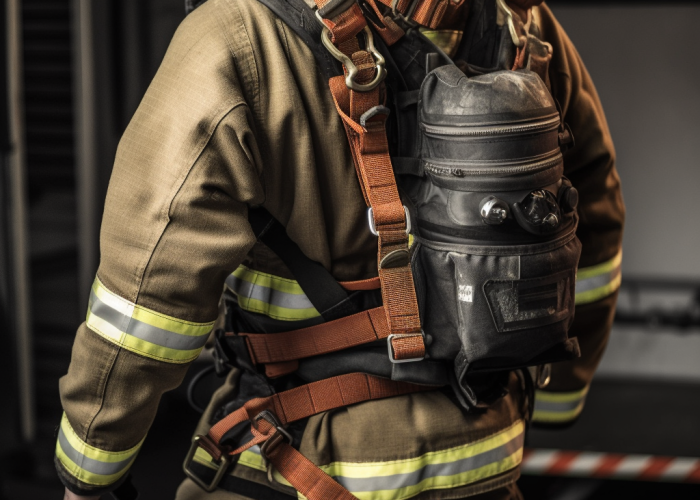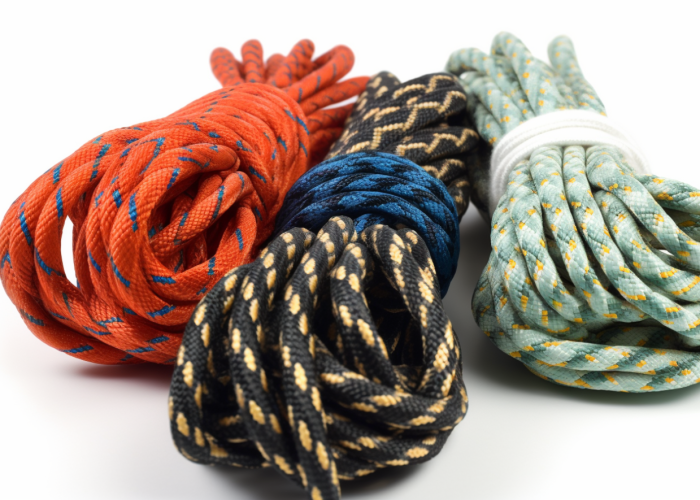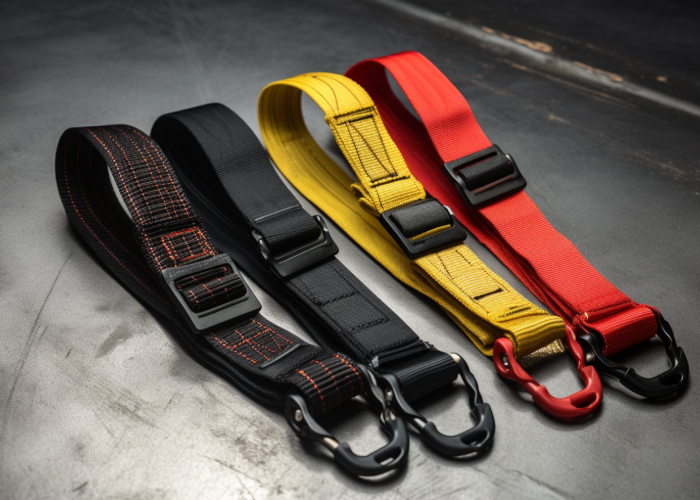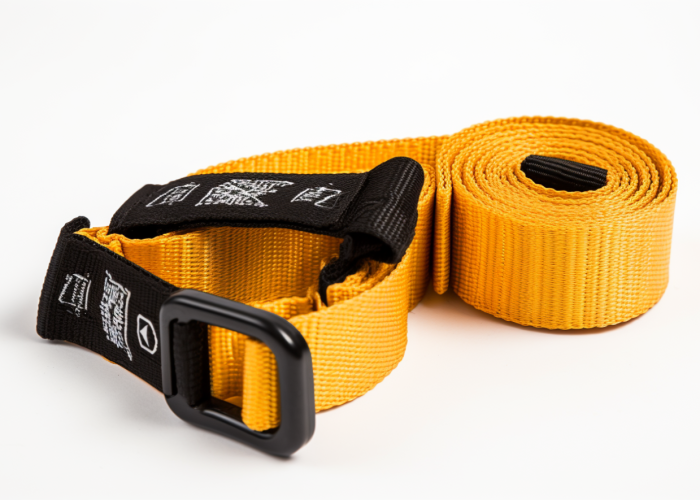Selecting flame-retardant webbing is critical for applications where fire safety is paramount. With over 15 years of experience testing and manufacturing specialty webbing materials, we’ve developed extensive knowledge about flame-retardant properties and performance across different industries and applications.
The flame-retardant webbing materials available are Nomex para-aramid for inherent flame resistance and treated nylon with phosphorous-based flame-retardant chemicals for chemically enhanced FR properties.
Compare performance, heat resistance, and wash durability of two FR webbing types to choose materials that meet safety and long-term performance needs.


Webbing manufacturing expert with 15+ years of experience helping product developers build high-performance straps for industrial, medical, and outdoor use.
Two main types of flame-retardant (FR) webbing are used in industry: inherently flame-retardant materials like Nomex (para-aramid), and chemically treated materials such as FR-coated nylon. Inherent FR options provide permanent protection through molecular structure, while treated types offer cost-effective performance through surface additives.
Material Performance:
In our manufacturing experience, inherent FR materials demonstrate superior performance consistency across temperature cycling and environmental exposure. We’ve seen applications where chemical treatments failed unexpectedly due to washing or UV exposure, creating liability concerns for product developers. Conversely, treated options provide significant cost advantages for applications with defined replacement schedules.
Both material types can achieve UL94 V-0 certification, though inherent materials maintain compliance throughout their service life without reapplication requirements.
For applications requiring guaranteed long-term FR performance such as aerospace or firefighting equipment, specify inherent FR materials like Nomex. Choose treated options for cost-sensitive applications with regular replacement cycles like automotive interiors or electronics housings. Consider your product’s expected service life and safety requirements when selecting between permanent and temporary FR solutions.

Both Nomex para-aramid and chemically treated nylon achieve UL94 V-0 certification for self-extinguishing properties, but compliance mechanisms and long-term reliability differ significantly. UL94 V-0 requires materials to self-extinguish within specific timeframes and produce no flaming drips during standardized flame testing.
UL94 V-0 Performance:
Our testing facility regularly validates UL94 compliance using controlled flame application protocols that measure ignition time, burn duration, and afterglow characteristics. We’ve manufactured webbing for aerospace applications where sustained UL94 compliance throughout 10+ year service lives is mandatory, making inherent FR materials the only viable option.
UL Recognition applies to polymers in uniform applications, with specific regulations governing FR webbing used in electronic enclosures and safety equipment. UL94 compliance affects product certification timelines and regulatory approval processes, particularly for consumer electronics and transportation applications.
For applications requiring permanent UL94 compliance such as aircraft interiors or industrial equipment, specify Nomex para-aramid. Use treated nylon for initial compliance requirements where periodic replacement is acceptable and cost optimization is priority.
Nomex para-aramid maintains structural integrity at continuous operating temperatures up to 260°C (500°F), compared to polyester’s 245°C (473°F) melting point and treated nylon’s ~200°C (392°F) effectiveness threshold. For base material comparison, see the FR Webbing Types section above.
Temperature Limits:
Through extensive thermal testing, we’ve documented substantial safety margins for extreme environments. In manufacturing applications, we’ve seen design failures where improper temperature rating selection led to webbing failure during welding operations or industrial oven exposure. High-temperature environments like steel mills and glass manufacturing require materials maintaining strength above 300°C.
NFPA and OSHA regulations specify minimum temperature resistance requirements for different industrial applications, affecting material selection for compliance.
For applications with continuous heat exposure above 250°C, specify Nomex para-aramid with appropriate safety factors. Choose polyester for moderate temperature environments below 200°C, and use treated nylon only for ambient temperature applications.

Chemical FR treatments maintain effectiveness for 25–50 wash cycles under standard conditions, but actual durability varies significantly based on detergent types, water temperature, and UV exposure. For material comparison details, see the FR Webbing Types section above.
Treatment Durability:
Our durability testing protocols simulate real-world washing conditions using industrial laundry equipment and measure FR performance degradation over time. We’ve worked with manufacturers who experienced safety incidents due to unmonitored treatment degradation in high-use applications requiring frequent cleaning.
From a product development perspective, applications like protective clothing, safety harnesses, and medical textiles face performance uncertainty as treatments degrade. Industry standards like NFPA 2112 specify periodic testing requirements for treated FR textiles to ensure continued compliance.
For applications with frequent washing requirements or extended service lives, choose inherent FR materials like Nomex that maintain properties indefinitely. Use treated materials for controlled-use applications with defined replacement schedules and washing cycle monitoring.
Safety harnesses require webbing that retains mechanical strength under high load and remains flame-resistant during exposure to sparks, heat, or fire. In high-risk environments, Nomex webbing is ideal for its inherent FR performance, while treated nylon may suffice in lower-risk settings with controlled replacement cycles.
Key Safety Harness Requirements:
From our manufacturing experience in industrial PPE, flame resistance failures often go unnoticed until critical moments—particularly when standard webbing survives load testing but degrades after repeated thermal exposure. Steelworkers and maintenance technicians working near welding or grinding tools need harnesses that hold up to both mechanical and flame stress.
Where performance can’t be constantly monitored, Nomex para-aramid webbing ensures consistent protection without the need for re-treatment. For lower-risk applications with planned inspections or replacements, FR-treated nylon may be sufficient—provided it’s kept within service life limits.
Recommendation:
Use Nomex for welding, smelting, or confined space rescue. Use treated nylon for construction or general industry with proper inspection protocols.

Inherent flame-retardant (FR) fibers like Nomex offer permanent protection, while chemical treatments applied to materials like nylon provide cost-effective, short-term solutions. The best choice depends on your ability to monitor and manage FR performance over time.
Performance Comparison:
Our experience shows inherent FR materials reduce lifecycle complexity—especially in field-deployed gear with unpredictable maintenance. Treated webbing can work in static applications (e.g., automotive interiors or consumer electronics) where replacements are scheduled or risks are low.
Recommendation:
Use inherent FR when performance monitoring isn’t feasible or consequences of failure are severe. Use treated FR when cost is a priority and lifecycle tracking is possible.
Industries where fire risk overlaps with safety or compliance concerns—like aerospace, marine, and firefighting—require certified FR webbing. Each sector has its own test standards and certification burdens.
Certification Requirements by Industry:
Certification timelines vary widely. For aerospace, full qualification including burn, toxicity, and aging testing may take 12–24 months. Firefighting and marine certifications can be faster but still demand documented compliance and often periodic retesting.
Recommendation:
Start compliance research before material selection. Work with vendors familiar with FAR, NFPA, or IMO standards to reduce delays and cost from retroactive testing.
omex webbing can reduce total cost of ownership by eliminating the need for flame-retardant reapplication, replacement tracking, or field failure risk. Its value depends on operational risk, lifecycle expectations, and safety criticality.
Cost-Benefit Breakdown:
In industries like welding, aviation, and emergency response, we’ve seen treated materials fail under unexpected exposure, causing performance gaps that only became obvious during audits or incidents. Nomex eliminates this risk—especially when workers may not report damage or replacements aren’t strictly enforced.
Recommendation:
Use Nomex where flame failure = high liability, legal, or brand risk. Use treated materials for low-criticality or disposable-use applications.
Nomex para-aramid provides permanent flame resistance for critical applications requiring long-term reliability and high-temperature performance. Treated nylon offers cost-effective FR protection for applications with defined replacement schedules. We support engineers in selecting compliant, application-optimized materials—contact us for technical consultation and custom FR webbing solutions.
Monitor FR-treated webbing after 25 wash cycles by conducting simple flame tests or visual inspections for treatment degradation. Replace immediately if webbing shows signs of melting, discoloration from heat exposure, or fails to self-extinguish during testing. Establish replacement schedules based on actual wash frequency rather than maximum ratings.
Automotive interiors typically require treated nylon meeting FMVSS 302 flame spread standards, offering cost-effective protection for moderate temperature exposure. For engine compartment or exhaust applications, specify Nomex for continuous high-temperature performance above 200°C.
Minimum orders vary by customization complexity: 500 yards for standard colors and widths, 1,000 yards for custom widths or weave patterns, and 2,000 yards for specialized FR treatments. We offer sampling programs to validate specifications before full production runs.
Nomex typically costs 2-3 times more than treated nylon initially, but provides permanent FR properties without replacement cycles. For applications requiring more than 50 wash cycles or service life exceeding 2 years, Nomex often delivers better total value when replacement costs are included.
Certification timelines range from 4-6 weeks for standard industrial applications using existing qualified materials to 6-12 months for aerospace or marine applications requiring new material qualifications. Early engagement with certification bodies accelerates approval processes significantly.
Yes, we supply comprehensive certification packages including UL94 test reports, material traceability documentation, and industry-specific compliance certificates. Documentation requirements vary by application—aerospace needs extensive batch records while general industrial applications require basic compliance certificates.